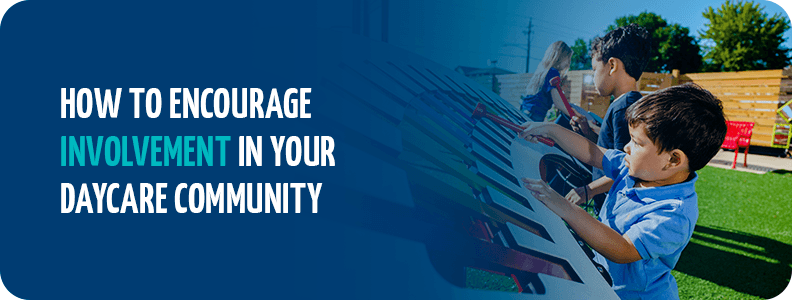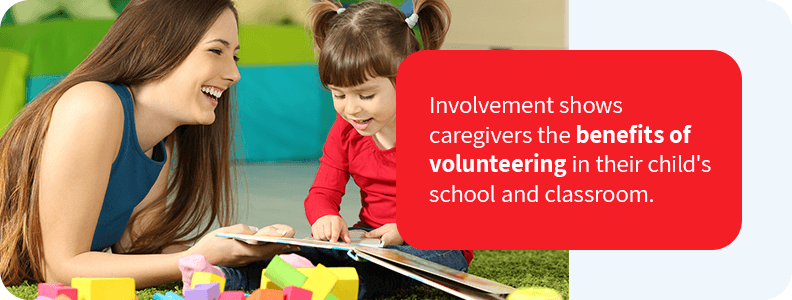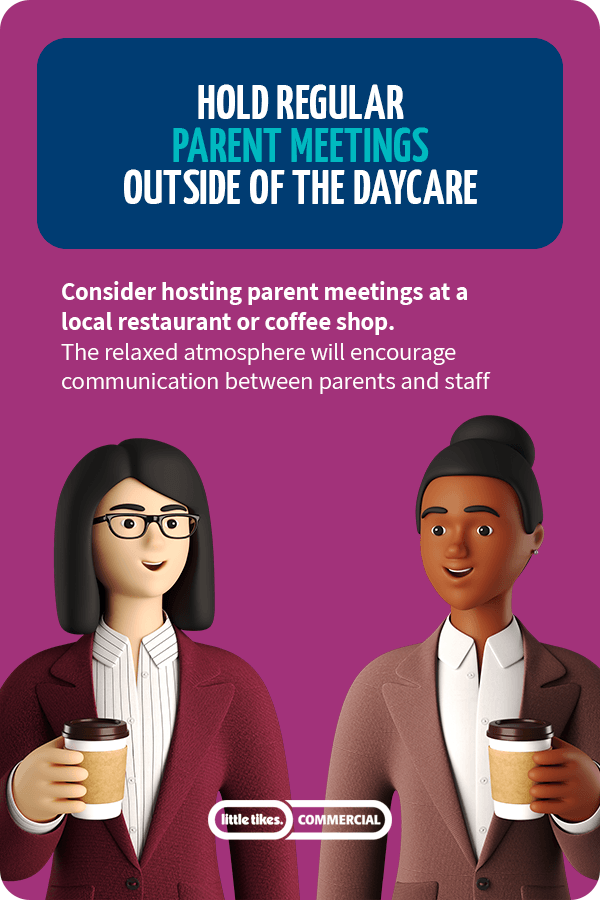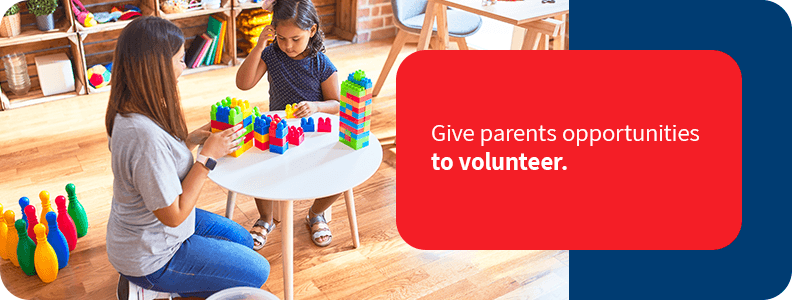
How to Encourage Involvement in Your Daycare Community

Parents always want the best for their kids, and that means they need a safe, secure daycare environment for their children. After all, a child’s early years are some of their most critical in terms of cognitive and physical development. Creating a positive daycare environment could make your business more appealing to parents. With over 8.7 million children in the United States enrolled in pre-primary school institutions, it’s never been more essential to create an environment that benefits children’s growth and development.
For many daycares, success comes from beyond offering a top-notch facility and services for children. Getting parents and guardians involved in your daycare community can improve your facilities, making your services more attractive to parents. These caregivers will come to you for childcare and stay for the community you’ve curated.
Parental involvement extends the educational environment beyond the doors of the daycare and into the home. Parental involvement reinforces what a child is learning in the classroom and extends the impact of what they’ve learned. As a daycare owner or worker, you can encourage parents to take an active role in reinforcing whatever developmentally appropriate skills you introduce in lessons. You can also encourage their participation with strategies to involve parents in childcare to foster a sense of community.
Read the full article or jump to a specific section:
- The Importance of Parental Involvement for Daycares
- Tips for Getting Parents Involved
- Activities to Get Parents Involved in Your Daycare
- Create a Playground for Your Daycare Community with Little Tikes Commercial
The Importance of Parental Involvement for Daycares
Encouraging parental involvement is about more than urging parents to help their kids succeed. Parental involvement in the daycare community:
1. Encourages Involvement Through the Rest of the Child’s Life

Parents who are involved in their child’s classroom early on typically maintain more involvement throughout their child’s school years. In other words, involvement in the daycare community shows caregivers firsthand the benefits of volunteering in their child’s school and classroom. When parents experience these benefits for themselves, they are more likely to continue to pursue opportunities to stay involved.
2. Helps Extend Teaching Outside the Classroom
When parents engage with their children and their peers, they see firsthand what they’re learning. Parents can then help reinforce those same concepts at home. For instance, if a class of 3-year-olds is working on the concept of sharing, using certain games or songs to reinforce the concept, parents can learn and adopt these same games and songs at home.
As children are consistently exposed to these same concepts in both their home and daycare environment, it reinforces their importance in their minds and memory. This reinforcement also helps parents get a better idea of concepts their child may be struggling with so they can work on them together at home. As a daycare teacher, you might notice improved learning back in the classroom, thanks to increased parental involvement.
3. Creates a More Positive Experience for Children
Younger children are especially prone to separation anxiety, especially in new or changing situations. When parents are involved in the classroom, they can work with you to identify problems and develop solutions to calm the student and help them adjust. Even if a child isn’t struggling with separation anxiety, parental engagement in the classroom shows kids that their caregivers value what they’re doing.
4. Helps Children Perform Better

Parental involvement will look different for each family. For some, it’s as simple as staying connected with their teacher via email or phone. For others, it may include volunteering to run class parties or read to the class once a week.
Whatever engagement you encourage caregivers to take at your daycare, know it will have a positive impact on your students’ overall performance in school. Besides creating a more positive experience for kids, engagement can also provide teachers and parents with a line of communication. They can easily identify and communicate problems early and resolve them before they become significant issues.
5. Increases Parent Confidence
Creating an engaged daycare community can go a long way toward cultivating confidence in caregiver’s parenting skills. Parents can learn a lot from the way you and other teachers interact with their children. In some cases, parents may pick up new ideas for how to address concepts like cooperation, problem-solving, or behavioral issues. In other cases, engaging in the classroom community can provide parents with affirmation that they are already doing the right thing.
6. Increases Parents Knowledge of the Child’s Development
Caregivers’ knowledge of how kids behave in the daycare classroom can inform their parenting at home. Some parents mistakenly believe that community involvement at this level requires in-person presence. But many times, they can be engaged by maintaining open lines of communication with you and your fellow teachers. Daycares can promote involvement by sending home regular newsletters and updates to parents. Caregivers can then be proactive about their involvement by communicating with the teacher about any questions or concerns they have.
7. Helps the Parents Better Understand the Teacher’s Job

When parents take the time to become invested and engaged in your daycare community, they increase their understanding and support of the incredible job you and your fellow teachers do. It’s hard work keeping a group of young children engaged and on track. Engagement can cultivate an appreciation for teachers and go a long way toward promoting positive relationships between caregivers and your daycare employees.
Tips for Getting Parents Involved
It’s easy to talk about involvement, but actually achieving parental involvement takes a few considerations. After all, children attend daycare because their parents have jobs, and many have siblings who also require time and attention. But involvement doesn’t mean asking parents to devote hours each week to physically being in the classroom. When it comes to how to encourage family involvement in the classroom, you’ll find it can actually be accomplished in many different ways.
Invite Parents to Learn More About Your Staff and Facility

If possible, holding a quarterly open house gives newer parents the chance to see the school and “experienced” parents the chance to get in and ask questions. It also lets teachers interact with parents and get to know them. If it’s not possible to hold an in-person open house, use the power of social media to let parents get comfortable with the daycare. Offer live tours — when children aren’t in the rooms to maintain privacy — and regular getting-to-know-you posts that introduce the teachers and say something about them.
On a more regular basis, consider sending home paper or e-newsletters updating parents on what’s going on at school and how their students are doing. These can be general newsletters for the entire daycare or each classroom can personalize them to reflect what’s going on there.
It’s also a good idea to offer transparency to parents. Be clear about how they can contact their child’s teacher, as well as the daycare’s director and other key staff members. If your staff responds better to email, make their email addresses public information. If you’d rather parents call, make that known, too.
Invite Parents to Participate in the Classroom
Some caregivers have the flexibility to help in the classroom from time to time. Invite parents to read, assist with holiday parties, or help at school-wide events. Have parents who work long hours and can’t be there in person? Offer opportunities for volunteers to make decorations for holidays or donate regularly used items that aren’t covered by the daycare’s budget.
Even donating supplies or snacks periodically helps parents feel like they’re contributing. And when parents feel like they’re contributing, they feel engaged in their child’s world. Remember, even if a parent can’t do more than donate supplies the first time you ask, you can offer other opportunities later. Their schedule may change, or eventually, they may feel the freedom to contribute in a bigger way.
Ask Parents for Input on Lessons in the Classroom
Early childhood education does typically follow a curriculum, but there’s a lot of room for creativity and exploration at this age. Invite parents to contribute suggestions about what they’d like their child to encounter in the classroom. You may get ideas for promoting diversity among students or broadening your lesson plans. Encouraging parents and children to share information about their background or special family traditions makes everyone feel more included.
You can also solicit suggestions from parents about subjects their children are particularly interested in, such as dinosaurs, butterflies, and flowers. This participation ensures children will also remain more engaged because they’ll see something they love in their daily classroom experiences.
Activities to Get Parents Involved in Your Daycare Community
If you’re still looking for ways to get parents involved in your daycare community, consider implementing one — or more — of these great outreach ideas:
1. Host Events
Daytime is school time for children, but holding events outside of regular school hours is a great way to encourage parents to get more involved. Depending on your daycare’s size and budget, consider holding a school-wide cookout or Halloween costume contest. Some daycares may also host a school-wide musical performance once or twice a year to allow students to perform for their families. If you do host a musical performance, consider offering a light reception after to encourage parents to mingle with school staff.
Regular open houses are also an ideal way to feature the work the children are doing at daycare. Create these opportunities for parents to wander into their child’s classroom, see their artwork, and talk with the teacher about how things are going each day. Some parents will faithfully attend each open house, while others will attend periodically and be encouraged by what they see. These times can also be used to mingle with parents and encourage their curiosity and willingness to engage with daycare staff.
2. Hold Regular Parent Meetings Outside of the Daycare

It may be difficult to hold after-hours parent meetings at the daycare because they’ve already been there several times that day dropping off and picking up their child. Instead, consider hosting parent meetings at a local restaurant or coffee shop. The relaxed atmosphere will encourage communication between parents and staff and will be perceived as less of an inconvenience if the parents get to eat or enjoy a kid-free cup of coffee at the same time.
3. Offer Parenting Classes
During the day, daycare is all about the students. But consider offering after-hours classes for parents on engaging topics like “how to limit screen time” or “how to potty train your toddler.” While it may seem like an indirect way to solicit involvement, short classes like these help parents connect with each other and encourage involvement by making them feel like they’re part of a group.
You can also use this opportunity to showcase your staff’s knowledge about some of these topics so parents learn more about the intelligent, hardworking teachers caring for their children each day.
If you don’t have staff who are able to work overtime or have the knowledge in a particular subject area, consider inviting parents to share their expertise. Parents who are doctors may be able to speak about child development. Parents who are in business may be able to talk about saving for college or teaching children about money.
4. Conduct Outreach

School-to-parent outreach can take many different forms. The basic point of any daycare’s outreach efforts is to identify ways to include families in the regular activities the daycare provides. You could create in-person ways to engage families. Or, more often than not, outreach looks like finding ways to encourage parents to create and maintain a supportive community alongside daycare staff.
Creating a school newsletter or social media page is one way to keep parents in the loop about what’s happening in the classroom. If you — or the parents — aren’t comfortable with the school posting pictures of children online, you can still use social media to post announcements about upcoming events and teacher profiles.
As a daycare teacher or director, you can also get the parents involved in outreach efforts. Outreach may look like publishing a school calendar created from artwork students have designed and selling it as a fundraiser. Or it could mean creating a parent’s advisory board or identifying a group of parents who would be interested in reaching out to new families who may have questions. These key parents can also help plan for and develop these events and activities.
5. Develop Videos of the Kids in Action
If you have parental permission to film students, consider doing a series of “day in the life” videos that will allow parents to see firsthand what their children are doing in the classroom. These help parents feel more connected to their children and give them opportunities to identify ways they can help out.
For instance, a parent may notice that a teacher has a group of students who loves to read books. The caregiver may be inspired to offer to read to the class or donate books to keep the classroom library fresh. Videos like this may also be helpful to prospective parents by giving them a real look at what goes on each day. No tour or open house will give them the same look that a video will.
6. Create Daily Reports

Don’t underestimate the value of a daily report. Documenting the basics of a child’s day goes a long way toward helping their parent stay engaged. Daily reports prompt questions and conversations between parents and teachers. They help parents identify things they need to address at home with their child. And they help maintain consistency between a child’s school life and home life.
7. Touch Base With Hard-To-Reach Parents
Some parents are difficult to reach, either because their work schedule is hectic or because they aren’t convinced their involvement in their child’s daycare is crucial. Encourage teachers to make an intentional effort to reach out to these parents. Even those who don’t communicate regularly or volunteer in the classroom are typically loving parents who want the best for their children. Continuing to communicate — even if it seems one-sided sometimes — goes a long way toward helping them feel engaged and involved.
8. Host a Fundraiser
Fundraisers are a great way to bring the daycare community together for a good cause. If you don’t want to ask for money for the daycare itself, consider holding a fundraiser for a local community organization. Canned food drives at the holidays, clothing drives in the winter, or a bake sale to benefit a local non-profit unite the families at your school under the flag of a common cause.
If you do opt to raise money for your daycare, consider targeting a specific need, such as refreshing the school library or purchasing updated playground equipment. Select a specific dollar amount and keep track of the progress where students and their families can see it. Asking people to give to a specific and long-lasting cause helps them feel engaged in the school community and may also encourage them to get more involved to see the results of their donations.
9. Encourage Volunteering

Although this one may be more obvious, it bears repeating — give parents opportunities to volunteer. Some parents will be interested in volunteering in the classroom or around the school during the week. Other parents may be more inclined to help on an as-needed basis, such as at a school event or holiday party.
But don’t just rely on volunteers for the obvious things. Consider asking a parent or two to serve on a committee to update the school’s parent handbook. Or ask some parents who are already engaged to help identify other parents who may be willing to contribute their own time and talents. Parents can offer a different perspective than the director and other staff members, providing an invaluable resource to the daycare community.
10. Include Others
One of the best ways to encourage involvement in the daycare community is to become a community people want to be involved in. Create a warm, nurturing environment for parents as well as their children. Listen and engage with parents with respect and dignity. Avoid gossip and discourage cliques of parents from forming and intimidating others. Offer an environment that helps parents believe their ideas and input are valuable and nurture that.
Create a Playground for Your Daycare Community With Little Tikes Commercial
Just because caregivers aren’t with their children at daycare doesn’t mean that parents can’t — or shouldn’t — be involved. Figuring out how to involve parents in daycare activities, as well as continually reevaluating the steps you’re already taking, should be an important goal of any daycare community. It’s always a good time for fresh, new ideas!
At Little Tikes Commercial, our goal is to help children experience the wonder of childhood, and we can help you do just that at your daycare facility. Our playground equipment is designed to inspire big imaginations in little ones of all ages and stages. Browse our inventory online and get a quote today.

